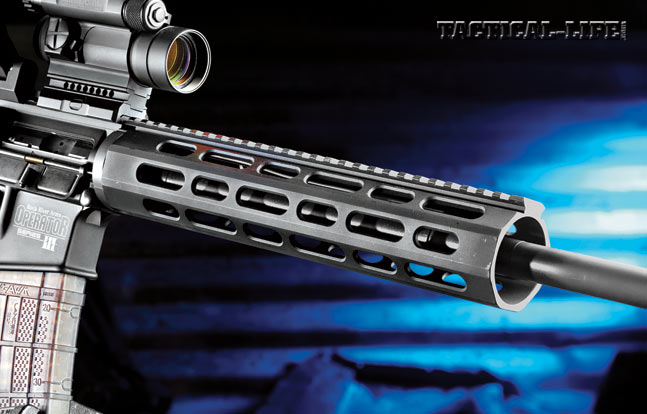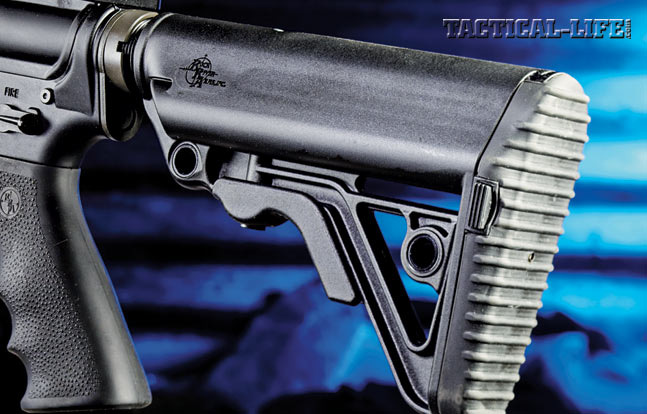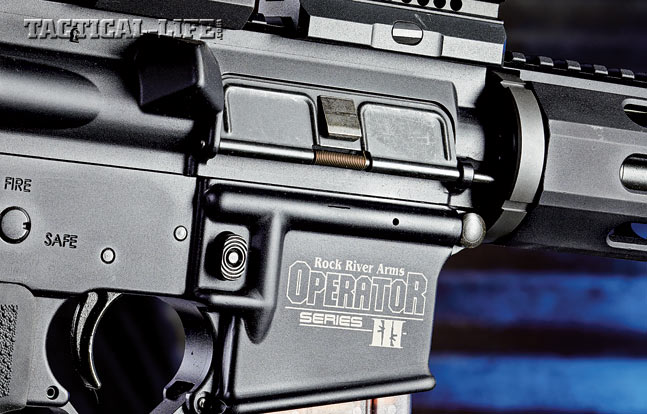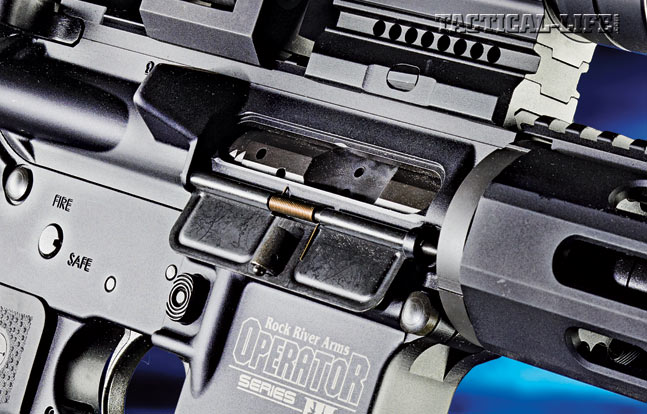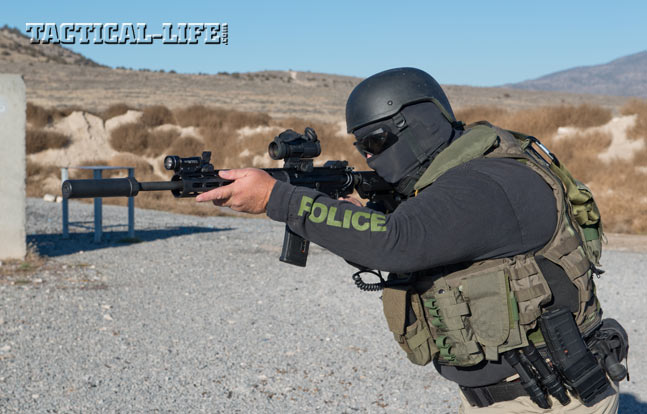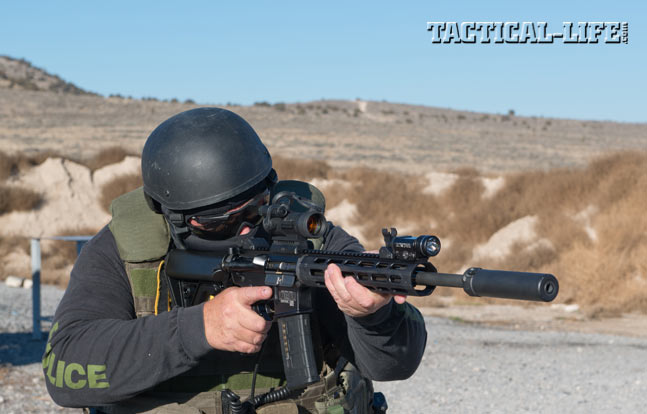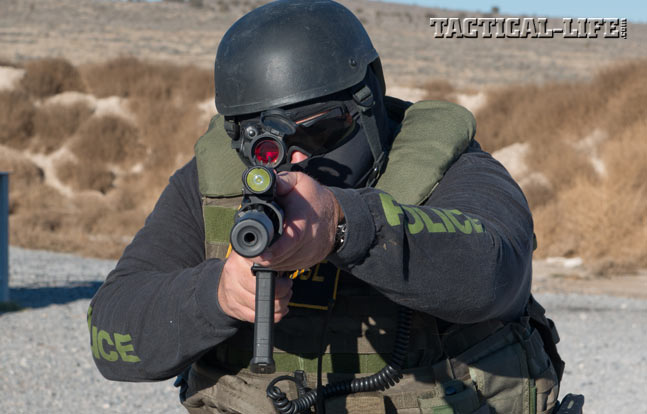Rock River Arms (RRA) has been building duty-ready AR-style rifles for law enforcement for years. The company started making ARs in the late 1990s, and in 2003 it secured a DEA contract for 5,000 rifles. After extensive testing, RRA’s “Government” model LAR-15 rifle beat out the 10 other manufacturers and quickly became a favorite among many officers and agencies. Fully equipped—including a railed forend, backup sights and an EOTech sight—it was pretty revolutionary for the time. Given the sea of AR rifles available today, it’s easy to forget how rare this was. Most of us were still getting used to guns with rails, and things like lights and holographic sights were pretty rare. RRA’s LAR-15 rifles were essentially custom-built rifles at production rifle costs, bringing top-notch quality to the average officer as well as rare features that have become mainstream today. RRA’s stable of rifles grew exponentially after that and eventually came to include the Operator series.
About three years ago, the Elite Operator hit the market sporting features designed specifically for professionals. It included a SOPMOD-style stock, an Ergo pistol grip and a forged A4 upper receiver. RRA also included its excellent two-stage trigger, a Star safety selector and a free-floating Half-Quad forend with a quad-rail forward section and a smooth rear portion. It proved very popular, resulting in a second generation followed by RRA’s latest rendition, the Operator III.

Gun Details
Advertisement — Continue Reading Below
The new Operator III starts with a forged LAR-15 lower receiver featuring RRA’s proven two-stage trigger, oversized winter triggerguard and Star safety selector. A Hogue rubber pistol grip provides for comfort and control. An RRA Operator CAR buttstock is installed on the six-position buffer tube.
“For most of the testing, I used an Aimpoint Patrol Rifle Optic (PRO). I also added flip-up front and rear backup sights…”
Chambered in 5.56mm NATO, the 16-inch, chrome-moly, heavy barrel has a 1-in-9-inch twist rate and is capped with the new Operator muzzle brake. The RRA TRO (Top Rail Octagonal) handguard covers the barrel and mid-length gas system, which utilizes a low-profile gas block. This forend is lightweight, comfortable and can be customized with various lengths of Picatinny rails as needed. The continuous top rail makes it easy for operators to mount any optics, sights and accessories. Two mil-spec 30-round magazines are included in the Operator III’s hard case.
For most of the testing, I used an Aimpoint Patrol Rifle Optic (PRO). I also added flip-up front and rear backup sights. For accuracy testing, I used a Bushnell Elite Tactical SMRS 1-6.5x24mm SFP scope with the BTR-2 reticle. This scope has seen significant time on several of my guns and provides for excellent precision.
Advertisement — Continue Reading Below
Along with the standard muzzle brake, I installed SureFire’s SOCOM flash suppressor to accommodate my SureFire SOCOM762-MINI suppressor. This design can be used with multiple calibers and operates with less backpressure than most. Coupled with 5.56mm carbines, it is fast becoming my favorite setup. It’s plenty quiet, maintains the weapon’s reliability and produces virtually no change in impact.
For transitions and work inside of a shoothouse, I added a Vickers sling from Blue Force Gear. Patrol rifles also need a light, and the Streamlight TLR-1 has become one of the most popular in law enforcement. It is simple, reliable, affordable and puts out plenty of light. I attached the new TLR-1 HL to the top rail, in front of the sight. This allows for ambidextrous operation with the sight up or down. The switch allows for momentary or constant operation along with a strobe feature.

Range Time
Advertisement — Continue Reading Below
RRA advertises the Operator III as being a 1-MOA rifle. Match ammunition met this guarantee, with most rounds grouping at or under an inch. Everything else fell inside 2 inches, making it plenty accurate. DoubleTap’s 55-grain full metal jacket (FMJ) took the day with a best five-shot group measuring 0.88 inches. The other round this rifle seemed to really like was the 77-grain OTM from Silver State Armory, which grouped right at an inch. The Operator III’s two-stage trigger and quality barrel certainly contributed.
“At 8 pounds, the Operator III is no lightweight to begin with, but it is very well balanced and solid as a rock…”
For the accuracy testing, I fired groups using a bag as a rest from a prone position, and the TRO forend kept things flat and steady. I also used only the Operator muzzle brake for this portion of the evaluation. As these things go for duty rifles, it is a good one. Recoil and muzzle rise were held to a minimum. Because the brake has no openings on the bottom, gas was directed up and to the sides. While certainly not quiet, it is not as loud as some other models out there.
Prior to moving to the shoothouse, I removed the brake and replaced it with my Surefire SOCOM flash suppressor. The three-prong design remains one of the best to date, providing excellent flash control. While it doesn’t help that much with recoil, the 5.56mm NATO is a soft-shooter, and this isn’t a big concern for a patrol rifle. Even so, the SOCOM flash suppressor accepts my SureFire SOCOM762-MINI suppressor, which takes care of that. Firing without the sound suppressor, there was no loss in accuracy, the carbine was very controllable and there was less of a concussive effect. Adding the sound suppressor did not shift the impacts downrange, nor did it degrade the carbine’s accuracy. Nor did it make the rifle unwieldy. At 8 pounds, the Operator III is no lightweight to begin with, but it is very well balanced and solid as a rock. Adding the SOCOM762-MINI did not seem to alter that noticeably. The carbine was easy to run in the shoothouse and remained reliable and accurate.
Advertisement — Continue Reading Below
Next I replaced the Bushnell scope with the Aimpoint PRO. While optics are great and fast becoming my preference on duty rifles, the Aimpoint PRO remains one of the most popular among officers and is perfectly suited to close-quarters work. It also makes for a pretty light and well-balanced system.

Moving back to the square range, accuracy at 50 yards off-hand was excellent using the red dot. Keeping everything inside a 4-inch circle was pretty easy, especially with the match ammunition. The Federal M193 ammo was also accurate and consistent. Even with a 1-in-9-inch-twist barrel, the Operator fired everything with solid accuracy. The TRO forend made off-hand and unsupported shooting very comfortable. My tendency these days is to keep side and bottom rails to a minimum—non-existent if possible. Mounting the TLR-1 to the top rail meant the rest of the forend was smooth and comfortable, helping me maintain control from awkward and non-traditional shooting positions. The Operator III was really easy to run around obstacles and from most any position.
“The Operator III was easy to control during the transitions, and there were no sharp edges to hang up on my gear…”
I completed the training and testing with some reload drills and transitions. Most of the testing was completed using Magpul Gen 2 PMAGs, which remain some of my favorites for duty rifles. They’re affordable, and they seldom fail. Although I panned window mags a bit early on, over time my opinion has changed—I like my duty mags to have windows. Another favorite of mine lately are the Lancer Systems Advanced Warfighter magazines. These are some of the most reliable magazines out there. They seem to work in any rifle I test, often where others have issues. One thing they seem to always do is drop free, making for some really quick reloads. In fact, many of my fastest and smoothest reloads were accomplished using them. I used several magazines with the Operator III, and all were flawless. I could reload from both the strong and weak sides without issue, and every magazine dropped freely when I hit the mag release.
Advertisement — Continue Reading Below
Moving to transitions, I mounted my Sig Sauer P226 SAO in my primary tactical rig and set up my sling for controlled drills. While sling cups exist on the rear stock, there is nothing to accommodate a sling on the forend. Rails can be added that accommodate several attachment devices, but no rails were provided with the rifle. You’ll need to take this into account when ordering your rifle. Luckily, the Operator CAR stock has cups at both the front and rear. This allowed me to turn the Blue Force Gear sling into a sort of single-point sling, facilitating transition drills. The Operator III was easy to control during the transitions, and there were no sharp edges to hang up on my gear.

Final Thoughts
All RRA rifles are built to order, so you may want to include some additions when ordering. The TRO handguard is fantastic—it’s smooth, light and comfortable—but if you want to mount a sling, make sure you get a rail, even a short one to accommodate a sling attachment. If you are going to use anything but a top-mounted light, you are going to need a rail for that as well.
Advertisement — Continue Reading Below
“Rock River Arms’ Operator III is in keeping with its lineage, providing a fantastic base for any duty rifle…”
Mid-length gas systems for 16-inch-barreled carbines are quickly becoming the norm. They just tend to be more reliable with less over-gassing in my experience. The Operator III is an excellent example. Even with the SureFire sound suppressor attached, very little excess gas made its way towards my face. Using the flash suppressor or brake, it was very clean to shoot. The gun was reliable using all of the muzzle devices—that’s not something you always see with standard direct gas impingement rifles. Another nice touch is the muzzle brake; although it’s timed, it does not require shims. RRA uses a standard crush washer, making installation simple.
The rifle’s fit and finish were excellent as usual, and the Operator III is perfectly suited to duty work of any kind. RRA’s two-stage trigger remains one of the best you can get without the high-dollar price tag. It remains reliable under hard use yet provides for significant precision when needed. The winter triggerguard offers plenty of room for gloved hands, certainly critical in climates with cold winters or where tactical gloves are used.
Overall, Rock River Arms’ Operator III is in keeping with its lineage, providing a fantastic base for any duty rifle. With a suggested retail price of just $1,065, it is a fantastic buy. Just add a light, sights of your choice and some sling attachments and you are ready to operate on any level.
Advertisement — Continue Reading Below




